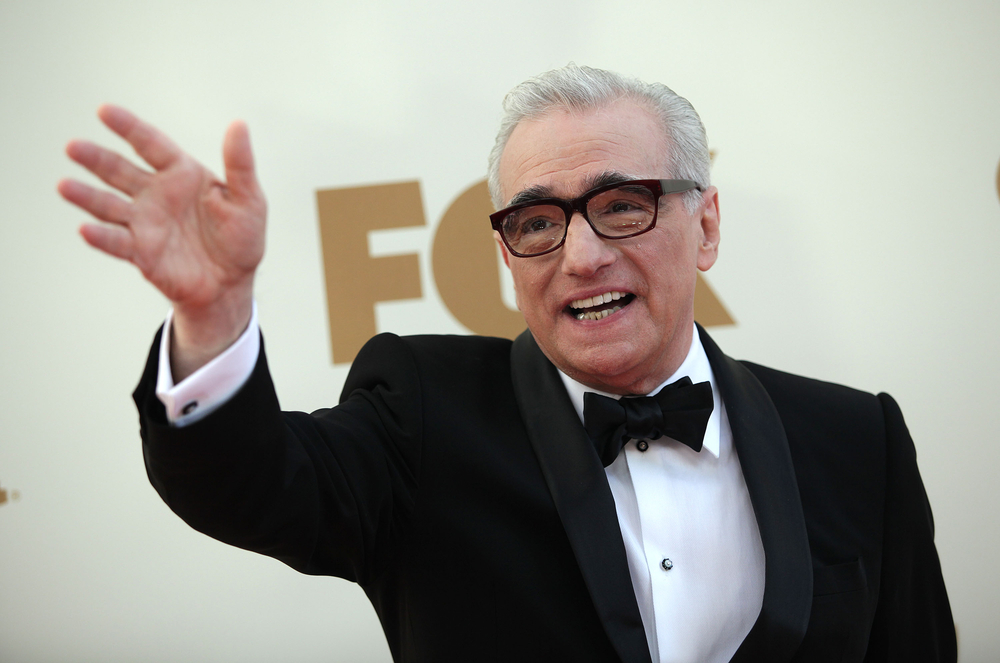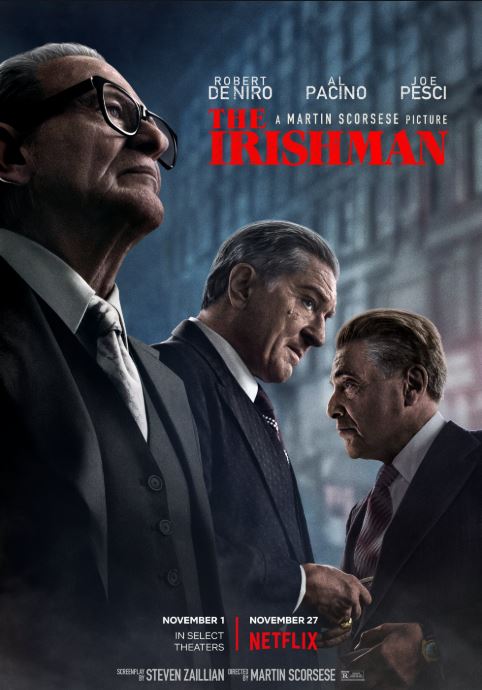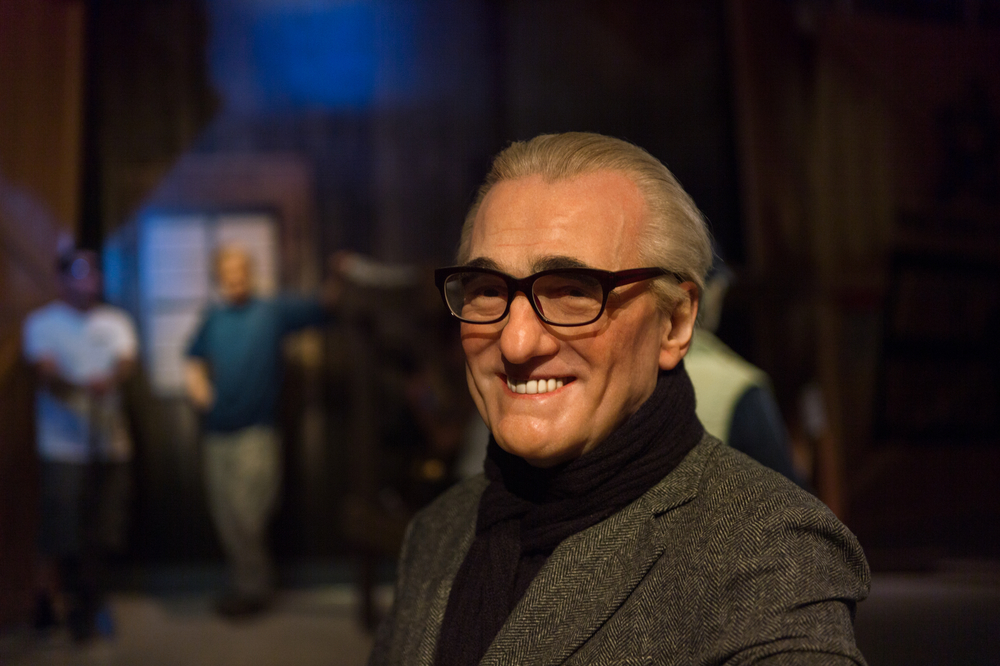Martin Scorsese is the most alive he’s been in his work in a long time, brimming with renewed passion for filmmaking and invigorated by the reception that has greeted his latest gangland magnum opus, The Irishman.
And what he wants to talk about is death. Just to be clear, he’s not talking about the deaths in his movies or anyone else’s. “You just have to let go, especially at this vantage point of age,” he said one Saturday afternoon last month.
The 77-year-old director was stretched out in a comfortable chair in a living room of his Manhattan townhouse, a seat he would rise from several times when a whimsical mood struck him during a spirited conversation about mortality and its inevitability.
As he explained, Scorsese was talking about setting aside his expectations for The Irishman. But he also meant relinquishing physical possessions: “The point is to get rid of everything now,” he said, in his trademark mile-a-minute clip. “You’ve got to figure out who gets what or not.” And the last step in this process is to let go of existence itself, as we all must.
“Often, death is sudden,” he continued. “If you’re given the grace to continue working, then you’d better figure out something that needs telling.”

Scorsese said he was aware of the wider debate about the representation of women in his films, acknowledging that The Irishman is a “more sequestered” movie but not solely representative of his body of work. Shutterstock
A CHANGING WORLD
The Irishman took more than a decade to make, and as its cast grew to include Harvey Keitel, Pesci and Pacino (who had never worked with Scorsese), the director could feel the stakes getting higher. That anxiety of influence was palpable, too, for collaborators like Steven Zaillian, the screenwriter, who strove not to duplicate other Scorsese films.
“It’s very hard to get all his movies out of your head and not write a scene that’s reminiscent of another scene — ‘Oh, oh, that’s what I did in Goodfellas or that’s what I did in Casino,” Zaillian said.
But such pressures also led to innovations like the captions that appear throughout The Irishman, describing how various criminals eventually met their fates.
Pacino, though a novice to Scorsese’s process, said he nonetheless developed an easy shorthand with the director and found him unafraid to express his opinion, in his own unique manner.
After one take, Pacino recalled, “I have a memory of Marty looking at the scene on a computer and sticking his head out of the tent that he was in, as if to say, ‘What the [expletive] are you doing?’ He didn’t actually say those words, but it felt like it. And I get the message.”
With a laugh, Pacino added that he welcomed such indications that a director was invested in his performance. “Actors like that,” he said. “You think, I’m glad you’re seeing me and I’m glad you’re actually evaluating what I’m doing. It’s saying, we’re not alone here.”
De Niro, who has starred in nine features for Scorsese, said the director’s openness to experimentation and in-the-moment discovery has remained a constant throughout their decades-long collaboration, dating to Mean Streets (1973).
“If he feels that something’s not within the parameters, that it’s too out-there, he might say no, or he might even say, ‘Try, let’s see,’” said De Niro, who is also an Irishman producer. “He can always cut it out. That gives you freedom to try things and it makes everybody comfortable.”
But De Niro said he and Scorsese also shared a kind of fatalism — the expectation that any time their work is celebrated, a barrage of rejection will swiftly follow, even in the case of The Irishman, which has been widely acclaimed.
“You’re waiting for, what’s the bad?” De Niro said. “What’s the downside? What’s going to happen? The other shoe to drop. You’re saying, yeah, this is great, but let’s not all get too excited.”
In ways both subtle and substantial, Scorsese sees the world changing and becoming less familiar to him. He gratefully accepted a deal with Netflix, which covered the reported $160 million budget for The Irishman. But the bargain meant that, after the movie received a limited theatrical release, it would be shown on the company’s streaming platform.
That means some viewers are watching the three-and-a-half-hour movie incrementally, instead of in one sitting, as its director would prefer. But Scorsese said he’d rather the film be available somewhere, in some form, than nowhere. “Even if it’s going to be shown on a street corner, maybe someday it’ll be shown in a theatre as part of a retrospective,” he said. “I really thought that.”
Netflix said The Irishman was watched by more than 26.4 million accounts in its first week on the site, but the realm of smartphones, tablets and streaming devices is largely invisible to Scorsese.
Sarcastically describing his day-to-day reality, he said, “I go out, they put me in a car, they take me somewhere, they take me out, put me back on a table, take me in. I go in a room, somebody talks to me, I say, ‘Yes.’ Then I come home and try to get in this door without the dogs going crazy.”
He is capable of adapting and evolving: In his fifth marriage (he and Helen wed in 1999), this former one-man tempest recast himself as a homebody and family man. They have a daughter, Francesca, and he has two daughters, Cathy and Domenica, from his first two marriages.
FINDING THE HEART OF THE STORY
Scorsese is perpetually reliving this history, telling tales of revelling in Citizen Kane when he watched it on a butchered TV broadcast years ago or being awe-struck when John Cassavetes, a hero and mentor, was given what seemed like the princely budget of $1 million to make Husbands, his 1970 comedy-drama about men in midlife crisis, for Columbia Pictures.
Being an avid movie fan is no guarantee that you’ll be a great moviemaker. But Leonardo DiCaprio, who has starred in five of Scorsese’s features, said that the director’s cinephilia never causes him to lose sight of what his performers need.
“He’s learned as much as he can about the history of his art form and he’s brought that all into his filmmaking process,” DiCaprio said. “But he’s always focused on what the actor gives, and that one-on-one dynamic. Plot to him is secondary. His focus is finding the heart of the story through the actors that he works with.”
Scorsese has equally vivid memories of his childhood, growing up in Little Italy where his formative influences included his parents, his Catholic priests and the local hoodlums who would inspire films like Mean Streets. If his past movies tended to glamourise criminals and the violence they perpetrate, Scorsese said, “Well, it is glamorous and attractive, is it not? It’s glamorous at first if you’re young and stupid, which a lot of people are. I was.”
His youth was also an initiation into the culture of death: serving as an altar boy for requiem masses at St. Patrick’s Old Cathedral (Dies Irae was my favourite song,” he said), helping a friend deliver floral arrangements to funeral services. As a teenager, he lost two friends in close succession — one died of cancer, another in an accident — and one of the burials, at a graveyard near a factory, left a lasting impression on him.
“I said, ‘This is what it comes to?’” Scorsese recalled. “To squeeze us in a little plot of land in Queens somewhere, against this ugly, destructive backdrop? It was a shock and an awakening — an awakening to what, I’m not sure, but a change.”
An eye for macabre details and an unflinching willingness to depict them have served Scorsese well, but somewhere around the making of his Vegas mob saga Casino (1995) —particularly the scene in which Joe Pesci’s character is beaten to death and buried in a cornfield — the director began to wonder if he had pushed this skill set to its limit. “I said I can’t go any further with it,” he recounted.
Over the next two decades, he largely avoided projects in the crime-drama genre. (An exception was The Departed, for which he finally won an Academy Award.) But whatever the subject matter, Scorsese said he felt drained by these films, usually near their conclusions, when he inevitably found himself butting heads with studio executives who wanted the running times shortened.
“The last two weeks of editing and mixing The Aviator,” a co-production that included Warner Bros. and Miramax, among others, “I had left the business from the stress,” he recalled. “I said if this is the way you have to make films then I’m not going to do it anymore.”
He did not quit, of course, but he has increasingly turned to independent financiers to back his projects, believing that he and the studio system had become mortal enemies. “It’s like being in a bunker and you’re firing out in all directions,” he said. “You begin to realise you’re not speaking the same language anymore, so you can’t make pictures anymore.”
When De Niro approached him with the source material for The Irishman, in the midst of work on another potential Paramount film they would ultimately walk away from, Scorsese did not necessarily see it as an opportunity to make a grand pronouncement on his body of work or the mafia milieu. “I saw it as a danger,” he said, fearing that it would be dismissed as yet another mob drama on his resume.
The only reason to do The Irishman, Scorsese said, was if it addressed ideas he hadn’t previously confronted. “Is it going to be enriching?” he asked himself. “Are we going to learn about the invisible, the afterlife? No, we’re not.”
But the film could say something about “the process of living and existence, through the work we could do — you could depict it, the actors could live in it.” And he could not resist the story of criminals whose lengthy life spans become a curse that burns their misdeeds into their souls. He quoted a lyric from the Bruce Springsteen song Jungleland: “‘They wind up wounded, not even dead,’” Scorsese said. “And that’s even worse, in a way.”
The Irishman, he said, was not a repudiation of his previous crime dramas nor an expression of regret for how he’d depicted their swaggering characters. “I don’t think it’s regret,” he said. “This is different. Here, it’s the dead end, and everybody has to reckon at the end. If they’re given the time. And that’s where we’re headed.”
‘you’ve got to embrace it’
He found that inspiration in The Irishman, his mammoth dramatisation of the life of Frank Sheeran (Robert De Niro), a mob enforcer who claimed to have killed Jimmy Hoffa (Al Pacino).
It was not an angst-free undertaking for Scorsese — his movies never are — as he struggled with the idea of making another film set in the world of organised crime and hesitated about pursuing the project with Netflix instead of a traditional studio.
But what compelled him to abide these uncertainties was a story that went well past the scope of Goodfellas or Casino, to the waning days of Sheeran’s life, when he is left alone to contemplate the morality of his deeds. In words that Scorsese knew would resonate beyond the framework of The Irishman, he said, “It’s all about the final days. It’s the last act.”
He may occasionally talk like someone with nothing left to lose, when he is candidly holding forth on comic-book movies, the treatment of women in his films or what he feels is his tenuous place in the current film industry. But Scorsese remains deeply invested in his career, after more than half a century, and while The Irishman could easily provide a fitting coda, he has no intention of stopping here. What motivates him now, he said, is not fear of death but acceptance that it happens to everyone, an understanding that provides him with perspective. “As they say in my movie, ‘It’s what it is,’” he said. “You’ve got to embrace it.”
Like the man himself, Scorsese’s home is a monument to moviemaking. Aside from the stately fireplace portrait of Gouverneur Morris, a Founding Father and ancestor of the director’s wife, Helen, the most prominent decorations surrounding him were oversize posters of beloved films by Jean Cocteau and Jean Renoir, including three for Grand Illusion in this room alone. Across the hallway was the dining room where he had edited portions of The Irishman, Silence and The Wolf of Wall Street.

Scorsese found that inspiration in The Irishman, his mammoth dramatisation of the life of Frank Sheeran (Robert De Niro), a mob enforcer who claimed to have killed Jimmy Hoffa (Al Pacino). IMDB
‘don’t go for the surface’
But you also know that Scorsese is hardly a wallflower if you’ve followed his recent remarks against Marvel movies, which he said were “not cinema” and closer to “theme parks” in an October interview with Empire magazine. (He expanded on these remarks in a November Op-Ed in The New York Times.)
That prompted Robert A. Iger, the chief executive of the Walt Disney Company (which owns Marvel), to tell Time magazine that Scorsese’s remarks were “nasty” and “not fair to the people who are making the movies”, adding that he was seeking a meeting with the director.
Scorsese told me that he had reached out to Iger several months earlier, on behalf of his non-profit Film Foundation, which is seeking to restore and preserve movies in the 20th Century Fox library that Disney now owns. “Then all this came up,” Scorsese said with a chuckle. “So, we’ll have a lot to talk about.” (A Disney spokeswoman said the company was trying to set up the meeting between Scorsese and Iger.)
Scorsese has also been faulted by critics and others who have said that the female characters in The Irishman are not fully realised and exist only to react to the male characters; as their prime example, these critics often point to Anna Paquin, who plays the adult incarnation of Sheeran’s daughter Peggy and who has almost no dialogue.
But the director argued that Paquin’s character — whose wordless rejection of the aging Frank devastates him — was in no way diminished by her silence. As Scorsese explained, “Don’t go for the surface. The surface says, ‘I’m going to say something and there’s going to be two or three big scenes between me and my father.’ She doesn’t need to. She saw what he did. She knows what he’s capable of.”
Scorsese said he was aware of the wider debate about the representation of women in his films, acknowledging that The Irishman is a “more sequestered” movie but not solely representative of his body of work.
Emma Tillinger Koskoff, who is president of production at Scorsese’s Sikelia Productions company and has made films with him for more than a decade, vehemently rejected the notion that Scorsese had historically overlooked women.
“It’s silly,” she said, adding that Scorsese “is responsible for some of the greatest female characters in cinema history.” She cited the roles played by Ellen Burstyn in Alice Doesn’t Live Here Anymore, Lorraine Bracco in Goodfellas, Jessica Lange and Juliette Lewis in Cape Fear and Sharon Stone in Casino, among others.
Koskoff also noted that Scorsese has supported female directors by helping to produce films like Joanna Hogg’s The Souvenir. “I could go on and on and on,” she said. “He’s not making Lady Bird but it’s not like he’s opposed to that.”
Scorsese was circumspect when asked about movies from the past year that he had enjoyed, pleading modesty and the fact that he still needed to watch a lot of films, though he did say he had seen and liked Bong Joon Ho’s dark satire Parasite.
And he was well aware that Joker, the hit comic-book thriller, contained many homages to his own work — he had passed on an offer to help produce it, though Koskoff worked on the movie — but did not seem to be in a hurry to view it.
“I saw clips of it,” Scorsese said of Joker. “I know it. So it’s like, why do I need to? I get it. It’s fine.”
Despite his professed aversions, Scorsese is going back to the Hollywood studios for his next movie, Killers of the Flower Moon, which is adapted from David Grann’s non-fiction book about the murders of Osage Indians in 1920s Oklahoma and which will be financed by Paramount.
Scorsese has other aspirations but they have nothing to do with moviemaking. “I would love to just take a year and read,” he said. “Listen to music when it’s needed. Be with some friends. Because we’re all going. Friends are dying. Family’s going.”
One impediment, Scorsese admitted, is himself and a disposition that compels him to tell stories in the medium he knows best. “I’ll read a book or I’ll meet a person and I’ll say, ‘Ah! I’m going to make a film on this,’” he explained. “Over the years I’ve been able to do it. Now it’s narrowing way down.”
Then there is the other boundary — you know, death. But just because it’s unknowable and non-negotiable doesn’t mean it isn’t worth contending with every day.
“The problem is, time is limited and energy is so limited — the mind, also, of course,” he said. “Thankfully, the curiosity doesn’t end.”











